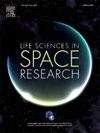Anthocyanin can improve the survival of rice seeds from solar light outside the international space station
IF 2.8
3区 生物学
Q2 ASTRONOMY & ASTROPHYSICS
引用次数: 0
Abstract
A purple-pigmented (purple) rice seeds containing an anthocyanin, a major class of flavonoids, and their isogenic non-pigmented (white) seeds were exposed outside of the international space station (ISS) to evaluate the impact of anthocyanin on seed viability in space. The rice seeds were placed in sample plates at the exposed facility of ISS for 440 days, with the bottom layer seeds exposed to space radiation and the top layer seeds exposed to both solar light and space radiation. Though the seed weight of both purple and white seeds decreased after exposure to outer space, growth percentages after germination of purple and white seeds in the top layer were 55 and 15 %, respectively, compared to those in the bottom layer 100 and 70 %, respectively. RNA analysis revealed that 1,590 and 1,546 seed-stored mRNAs (long-lived mRNAs) were degraded in the white seeds of the top and the bottom layers, respectively, whereas those of the purple seeds in the top and bottom layers were 548 and 303, respectively. These results suggest that anthocyanin protected seeds and safeguarded long-lived mRNAs from solar light and space radiation to increase the seed viability.
花青素可以提高水稻种子在国际空间站外的阳光下的存活率。
将一种含有花青素(一种主要类黄酮)的紫色水稻种子及其等基因非色素(白色)种子暴露在国际空间站(ISS)外,以评估花青素对种子在太空中生存能力的影响。水稻种子放置在国际空间站暴露设施的样品板中440天,底层种子暴露在空间辐射下,顶层种子暴露在太阳光照和空间辐射下。虽然外层暴露后紫色和白色种子的种子重量都有所下降,但紫色和白色种子在顶层萌发后的生长百分比分别为55%和15%,而底层萌发后的生长百分比分别为100%和70%。RNA分析结果显示,顶部和底部白色种子的长寿命mrna降解量分别为1590和1546个,顶部和底部紫色种子的长寿命mrna降解量分别为548和303个。这些结果表明花青素保护种子,保护长寿命mrna免受太阳光照和空间辐射,从而提高种子的生存能力。
本文章由计算机程序翻译,如有差异,请以英文原文为准。
求助全文
约1分钟内获得全文
求助全文
来源期刊

Life Sciences in Space Research
Agricultural and Biological Sciences-Agricultural and Biological Sciences (miscellaneous)
CiteScore
5.30
自引率
8.00%
发文量
69
期刊介绍:
Life Sciences in Space Research publishes high quality original research and review articles in areas previously covered by the Life Sciences section of COSPAR''s other society journal Advances in Space Research.
Life Sciences in Space Research features an editorial team of top scientists in the space radiation field and guarantees a fast turnaround time from submission to editorial decision.
 求助内容:
求助内容: 应助结果提醒方式:
应助结果提醒方式:


